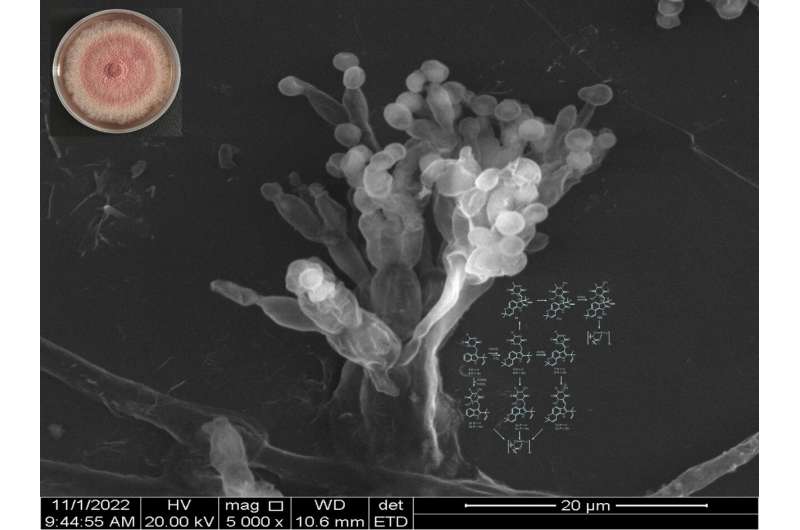
Thermophilic fungi are chief components of mycoflora in a variety of natural and manmade composting systems, including rotting hay, stored grains, wood mulch, nesting material of birds and animals, municipal refuse, and self-heating accumulated organic matter. Thermophilic fungi are also a potential source of natural products, which complement the metabolite libraries of mesophilic fungi and bacteria.
The research team led by Prof. Xuemei Niu (State Key Laboratory for Conservation and Utilization of Bio-Resources in Yunnan, Yunnan University) has been working on the discovery of secondary metabolites in thermophilic fungi and their biological activities and natural functions since 2007.
In early 2010, the team reported that a predominant thermophilic fungus Thermomyces dupontii produced a new class of prenylated indole alkaloids (PIAs), bearing the striking structural features of a key putative versatile precursor that has long been proposed for the well-known complex PIAs in mesophilic fungi.
In their latest study published in the journal Mycology, the team sought to determine why T. dupontii produced such a class of PIAs. They aimed at two P450 genes in the gene cluster responsible for PIAs, because P450 can modify and transform secondary metabolites to generate diverse and complex metabolites.
What’s more, the ecological importance of P450 genes remains poorly understood up to date. Unexpectedly, bioinformatics analysis indicated that one of the P450 genes is a unique fusion gene P450L that encodes two functional domains that were separately encoded by two independent genes in other fungi.
They established a thermophilic CRISPR/Cas9 system and constructed two mutant deficiencies in two P450 genes. The team performed metabolic analysis and detailed chemical investigation and found that two P450 genes have multifunctions in forming simple PIA-derived iron chelators, bolstering simple PIAs to complex PIAs, and yielding effective iron chelators. Surprisingly, they observed that the fusion gene P450L has an additional role in the formation of more complex iron chelators derived from new complex PIAs.
The researchers also evaluated the iron levels in the mutants and found that the P450-mediated metabolite modifications were involved in elevating Fe2+ levels but attenuating Fe3+ levels, thus leading to high ratios of Fe2+/Fe3+ in the thermophilic fungus under cold stress, which regulated mitochondrial contents and lipid formation in mycelia and contributed to strong and stout conidiophores, thereby facilitating thermophilic fungal conidial survival under cold stress.
As one of the basic and limiting physical factors in the environment, temperature plays a very important and even decisive role in the survival and distribution of organisms on the Earth’s surface. With the intensification of global extreme climate change, the research on adaptation and combating temperature change has attracted more and more attention.
The results in this study might explain why Thermomyces species with a large reduced genome can survive in the biosphere where temperatures are often below their growth temperatures. They suggest the fungus does not need many biosynthetic core genes for distinct families of metabolites, P450-mediated structural modifications can meet the needs of fungal low-temperature tolerance and survival ability.
“This study will encourage scientists working on structural diversity to discover the natural functions of modifying genes and to reveal all the unknown molecular secrets that the chemical diversity has,” Prof. Niu said.
More information:
Shuhong Li et al, Gene fusion and functional diversification of P450 genes facilitate thermophilic fungal adaptation to temperature change, Mycology (2024). DOI: 10.1080/21501203.2024.2324993
Provided by
Tsinghua University Press
Citation:
Exploring a molecular mechanism that facilitates thermophilic fungal adaptation to temperature change (2024, April 23)
retrieved 23 April 2024
from https://phys.org/news/2024-04-exploring-molecular-mechanism-thermophilic-fungal.html
This document is subject to copyright. Apart from any fair dealing for the purpose of private study or research, no
part may be reproduced without the written permission. The content is provided for information purposes only.







